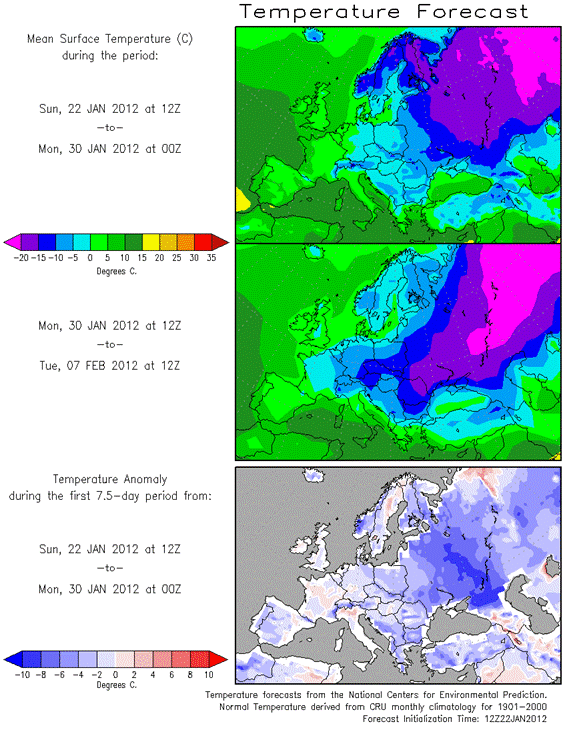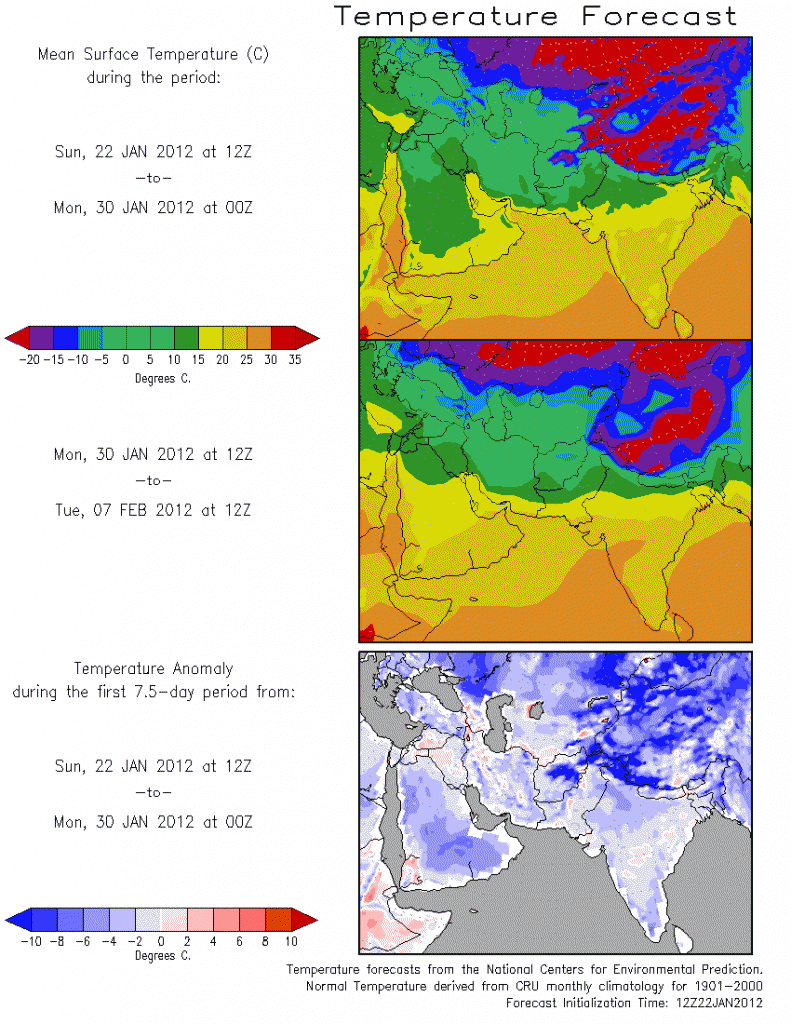The recent long-term forecasts for Europe show we most likely aren’t going to be escaping winter this year. Over the last week or so, the forecasts couldn’t seem to make up their minds, would it be cold or not cold?
Source: http://wxmaps.org/pix/temp4.html
One day the forecast showed cold on the way, and the next day the charts would be revised and showed mild weather in the pipeline.
But over the last few days, the signs have all been converging and showing that cold is on the way from Russia. Europe this year may get a hard winter after all – it may be just arriving late. The bottom chart for Europe shows the anomaly for the coming week. The middle chart shows the forecast for the week after. It’s going to get even colder. We’ll see how it pans out.
Asia is already freezing to death!
Below if you click on the charts for Asia, you see that cold is the story of the day. In fact it’s rare to see that much cold over such a vast continent.
Source: http://wxmaps.org/pix/temp11.html
The lower chart of central Asia shows below normal temps are forecast for almost every region for the coming week, and the middle chart shows even deeper cold for the week after, as we saw is the case for Europe.
Hansen ought to put his red crayons away and grab for blue or purple ones.
Charts for…
Central Asia: http://wxmaps.org/pix/temp11.html
East Asia: http://wxmaps.org/pix/temp5.html
South Asia: http://wxmaps.org/pix/temp6.html
North America: http://wxmaps.org/pix/temp2.html
Australia: http://wxmaps.org/pix/temp7.html
Africa: http://wxmaps.org/pix/temp10.html
Middle East: http://wxmaps.org/pix/temp9.html
South America: http://wxmaps.org/pix/temp8.html
Look at Asia and South America! See all the global warming?
Yet the kooks say it’s still too warm!
Remember that for the climate dummies, like Hansen, NOAA, and a host of others, this is still dangerously too warm. Temperatures are supposed to be a lot lower in order for the Earth to be normal and for life on it to be safe.
Yeah right! Go tell that to the billions of folks In Europe, Asia, Middle East and South America who are now struggling to stay warm.







Global tropospheric temperatures are way down as well.
AMSU Discover: January 19, 2012 : Coldest Day Globally In At Least 10 Years
http://www.real-science.com/january-19-2012-coldest-day-globally-10
The AO prediction for the next two weeks shows a strong negative trend which typically in the past has brought colder weather for Europe
http://www.cpc.ncep.noaa.gov/products/precip/CWlink/daily_ao_index/ao_index_ensm.shtml
As I mentioned on the previous post, taking a look at the AO situation is an interest of mine, it is hovering at the moment and I am worrying.
Winter can start late, 47 was a late starter:
“1946-47: The year you’ve most probably been waiting for! One of the snowiest winters to date, probably the worst since 1814 (see part 5). Snow fell on the 19th December in Southern England. Then there was a notable mild spell, extremely mild in parts, with 14c being reached by day. Then from the 22nd January, it began! There was continuous snow cover from this date, right up till 17th March! Late January saw 7 inches of snow in South West England and the Scilly Isles (unusual). Early February saw the turn of the Midlands (Southern) and East Anglia, while Northern England, North Wales and Eastern Scotland saw snow in late February. In early March there was a blizzard in England and Wales, with 1ft widely, and 5ft accumulated on the hills! 12th March saw snow for the Border Country. 1946-47 was strange, because it started up late, and lasted a long time. I think 2003-04 will mirror 1947 in lots of ways, mainly in terms of snowfall, but not so extreme and long lasting. Very snowy.”
http://www.netweather.tv/index.cgi?action=other;type=winthist;sess=
Hope it don’t get that bad, this country cannot cope, the UK is not used to it unlike – Canada!
Another late winter was 1968/69 (I think)
I lived at Stocksbridge, on the Pennines between Sheffield and Manchester. January was warm. I can remember opening the window to talk to the postman. When I said about the lovely sunny, warm day, his reply was, “We will pay for it”. And we did! The snow started falling on (I think) 1st Feb and continued for several days. The town was cut-off for 24 hours. The workforce at Fox’s Stainless steel works on the other side of the valley could not use their cars as the snow on climb up to the village was too deep and too slippery.
We had a visiting brass band on the 24 March and there was still heaps of snow of 0.5m on both sides of the road.
Hello together,
a real extreme example of the above is winter 1955/56. December has been 3 K too warm (in central Europe), January 1956 has been a little too warm. But then February… was about 9 K too cold! It made the whole winter a cold one. And I know from witnesses (my mother-in-law), that people in that year already had hope to escape severe winter weather (it seems, contrary to today, at that time one was happy if severe freezing was kept out).
Sorry I don’t know about more details. Perhaps just google it!
Chris Frey
Don’t stand under the wind turbines. (with picture)
http://regionales.t-online.de/windrad-teile-fliegen-hunderte-meter-durch-die-luft/id_53413702/index
Hassberg, Bavaria: A blade of a 80m high turbine burst; parts of the 35m long blade were distributed in a radius of 200m. The operator suspects that strong winds have lead to the damage. (You don’t say!)
OMG. They’re beyond salvage. From the photo, looks to me like some serious delamination.
If they were tougher, they could be upgraded to generate electricity. 😉
http://obviousinvention.wordpress.com/2012/01/22/redeployment-of-wind-powered-generators/
Forgot to write that the delamination could be caused by ingress of moisture and subsequent frosts. Putting it down to excessive wind (overload) without a detailed investigation is IMHO negligent.
http://www.cpc.ncep.noaa.gov/products/precip/CWlink/daily_ao_index/ao_index.html
Arctic Oscillation dipping into negative, who knows, it may yet be a cold one.
I’m in one of the areas where it’s a little warmer than usual; South-West Western Australia.
The heatwave forecast of near 40°C maxima for most of these 8 days is not unprecedented for the region. It happened about 50 years ago.
I’ll have to throw something on the solar hot water system when the tin roof cools off a bit because the water keeps boiling and venting some boiling water. Temporary paint for glass (as for Christmas decorations) might be called for. A recent summer storm washed the dust off the collector glass.
You’re lucky – enjoy it! Send some of it over to europe!
Phew,
I’d rather be hot and need to cool down than be cold and need to heat up – what you need there mate is a bit of the Freemantle Doctor!
Fremantle Doctor is definitely wished for. The conditions aren’t quite right to let that breeze penetrate past the sand dunes at the beach.
Forecast maxima (in °C) for Perth these next few days starting today:
39, 40, 39, 42, 40, 41, 41, 36, 33, 31
Fortunately, it’s dry. And I’m some way out from the “big smoke” or something else with the initials “BS”; so it’s already at least 3 degrees cooler than the official temperatures in Perth.
This “hot spot” will no doubt be radiating more energy than average back to space, all day and all night.
Looks like the cold has come to Europe:
http://www.real-science.com/buries-austria#comments
Deep freeze coming from the East: On Tuesday (it’s Friday today) we could reach -10 deg C, especially in Eastern Germany, according to this forecast.
http://wetter.t-online.de/wetter-naechste-woche-wird-s-klirrend-kalt/id_53536864/index